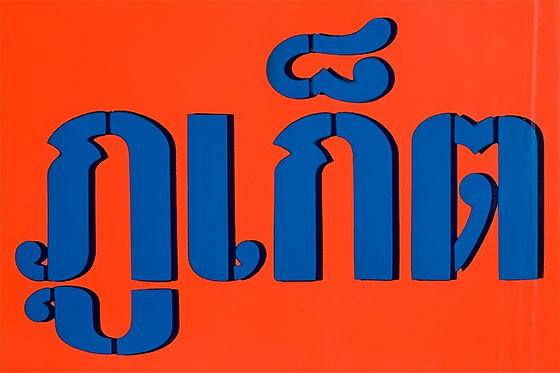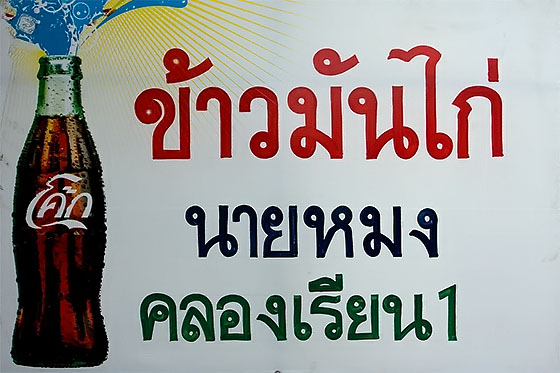Learn How To Read Thai - Tutorial 18
Thai Vowels Written Below The Preceding Consonant
I'm just going to cover two vowels today. They are important and used frequently.
As with other Thai vowels there are long and short versions of the same basic sound. The wonderful thing about written Thai is that different sounds use different vowels ... unlike English.
The English words 'book' and 'boot' use the same vowel combination but the words have different sounds. How does a foreign learner of English know which is which? As foreign learners of Thai, we have a big advantage over our unfortunate foreign counterparts.
These two Thai vowels are always written below the preceding consonant. They are always used on their own and never used in conjunction with another vowel to make a vowel combination. Here they are, written below the zero consonant:
อุ
Writing practice: Download Worksheet
First is the short version which makes a similar sound as in 'book' or 'put'. This is the case, unless you come from northern England where these short vowels are turned into long sounds but I can't account for English regional dialects.
Most transliteration systems tend to use an English 'u' for these vowels but when you see a 'u' is it like the 'oo' 'food', or the 'oo' in 'foot', or the 'u' in 'fun'?
The transliteration systems try to 'help' by turning the 'u' in 'fun' into an 'a' but that is inaccurate and only creates another problem.
As you may be starting to realise, transliteration systems are very poor. They are inconsistent and, for the most part, inaccurate. When you start speaking Thai you realise there are sounds that don't exist in English.
If you teach Thai students English, you will know from their difficulties that there are sounds in English that don't exist in Thai. To attempt to use one writing system for the other language is therefore bound to cause many problems (which it does).
The name of this vowel follows Thai naming conventions, thus being sara followed by the vowel sound. As I am writing this in English, I now need to attempt to write this sound using English letters but I don't really want to for obvious reasons. However, for the purpose of this exercise I will write it as sara uu.
Next is the long version of the vowel that I will call sara oo. This sound is similar to the 'oo' in 'food', 'rude' or 'boot' - it's a long sound compared to 'book' or 'put' (provided you're not from Yorkshire).
อู
Writing practice: Download Worksheet
Reading Practice

ภูเก็ต
You should recognise the initial consonant from the previous tutorial (Tutorial 17) which is one of the aspirated 'p' sounds. Underneath it is written the long vowel sound sara oo from above. The first syllable, therefore, is 'poo'.
With the second syllable you should recognise the initial consonant gor gai from Tutorial 1 as being a hard 'g' sound. You should recognise the final consonant dtor dtao from Tutorial 3 and you should know that as a final consonant it is pronounced with an unreleased 't' sound.
I'm hoping that that you will recognise the vowel sara ay used in conjunction with the vowel shortener symbol which makes an 'e' sound as in 'get' (Tutorial 16). Considering that our initial consonant makes a 'g' sound and our final consonant a 't' sound, our second syllable is 'get'.
The name of the large island in the south of Thailand poo-get is commonly transliterated as Phuket. This stupid transliteration gave rise to all sorts of stupid jokes about the pronunciation of the name but as you can see, the correct pronunciation sounds nothing like the stupid jokes.
Tone: Previously I had thought that with polysyllabic words, the tone was worked out separately for each syllable but Benjawan Poomsan Becker says: "For poly-syllabic words, in normal speech, the tone of the initial syllable tends to become a mid tone."
In that case, the first syllable is mid tone. The rules for the second syllable are:
Mid-class initial consonant, dead syllable, short vowel = Low tone (Tutorial 14)
ถูก
You should recognise the initial consonant as being one of the 't' sounds from Tutorial 15. Underneath it is written the same vowel as above, the long 'oo' sound, and the final consonant is gor gai (Tutorial 1) which is pronounced with an unreleased 'k' sound.
The Thai word took means cheap.
Tone: High-class initial consonant, dead syllable, long vowel = Low tone (Tutorial 14)
พูด
Do you recognise the initial consonant as being one of the 'p' sounds? You should do from Tutorial 17. The same long 'oo' vowel is used again and the final consonant is dor dek which, as a final consonant, is pronounced as an unreleased 't' sound. Do you see how easy this is?
The Thai word poot is the verb to speak.
Tone: Low-class initial consonant, dead syllable, long vowel = Falling tone (Tutorial 14)
รุ้ง
The initial consonant is an 'r sound (Tutorial 2) and the final consonant is the 'ng' sound (Tutorial 4).
This word uses the short 'uu' sound as in 'put'. The Thai word ruung means rainbow.
Tone: Low-class initial consonant and second tone mark = High tone (Tutorial 14)
คุณ
The initial consonant is one of the 'k' sounds Kor Kwaay (Tutorial 5) and you can see the short 'uu' vowel written underneath it.
The final consonant is one I haven't covered yet but it is another that makes an 'n' sound. The short Thai word kuun, normally transliterated as khun, is the polite form of the personal pronoun 'you' or a polite form of address.
Tone: Low-class initial consonant, live syllable = Mid tone (Tutorial 14)
Questions And Feedback
If you have any comments, questions or suggestions, feel free to contact me. Your feedback will help me to improve these pages.
Recommended Books
Amazon UK
Amazon UK
Amazon US
Amazon US

